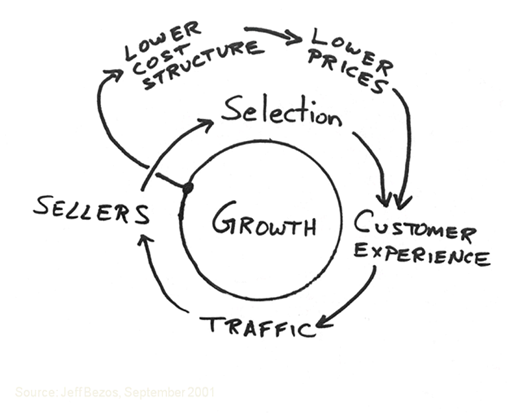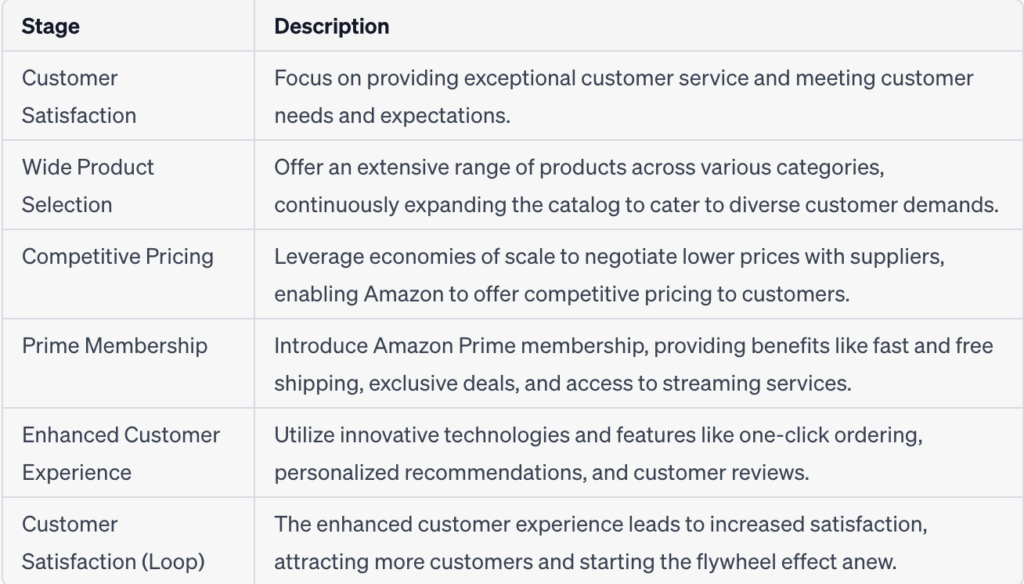How Amazon, Uber & Tiktok Achieved High Growth by Mastering the Startup Flywheel Effect?
Starting a business is no easy feat. It requires innovative ideas, perseverance, and a strategic approach.
One strategy that has proven immensely successful for companies like Amazon and Uber is the “startup flywheel effect.”
In his book “Good to Great,” renowned author Jim Collins explores the concept of the flywheel effect and how it can propel companies to become industry leaders.
In this blog post, we will delve into the principles of the startup flywheel effect as described by Jim Collins, and examine how Amazon and Uber effectively employed this strategy to achieve unprecedented success.
Understanding the Startup Flywheel Effect
Before we dive into the success stories of Amazon and Uber, let’s first understand the concept of the startup flywheel effect.
In “Good to Great,” Jim Collins describes the flywheel effect as a metaphorical concept that represents the momentum and growth of a company.
The flywheel is initially heavy and difficult to set in motion, but with consistent effort, it gains momentum, becoming easier to turn and generating even greater output.
For startups, the flywheel effect is all about identifying key drivers that can accelerate growth and create a self-sustaining cycle.
These drivers typically include customer acquisition, customer satisfaction, operational efficiency, and innovation.
By focusing on these drivers and creating positive feedback loops, startups can generate a continuous cycle of growth and success.

Amazon’s Flywheel Effect: From Online Bookstore to Global E-Commerce Giant
Amazon, founded by Jeff Bezos in 1994, started as an online bookstore. However, Bezos had a grand vision of building a company that would become “Earth’s most customer-centric company.”
Amazon’s flywheel effect was driven by a relentless focus on customer satisfaction and a commitment to continuous innovation.
Customer-Centricity and Wide Selection
Amazon recognized that to satisfy customers, it needed to offer an unparalleled selection of products.
The company relentlessly expanded its product catalog, ranging from books to electronics, clothing, and even groceries.
This wide selection attracted more customers, which in turn attracted more sellers to list their products on Amazon’s platform.
As more sellers joined, the selection grew further, creating a positive feedback loop.
Competitive Pricing and Prime Membership
Another driver of Amazon’s flywheel effect was its commitment to competitive pricing.
By leveraging its scale and negotiating power, Amazon offered products at lower prices compared to many brick-and-mortar retailers.
This attracted price-sensitive customers, leading to increased sales volume and further strengthening Amazon’s market position.
Amazon also introduced the game-changing Amazon Prime membership, offering benefits like fast and free shipping, exclusive deals, and access to streaming services.
Prime membership incentivized customers to shop more frequently on Amazon, thereby boosting customer loyalty and increasing sales.
Continuous Innovation and Customer Experience
Amazon’s flywheel effect was further fueled by its dedication to innovation and enhancing the customer experience.
The company introduced revolutionary technologies like one-click ordering, personalized product recommendations, and customer reviews.
These innovations made the shopping experience more convenient, personalized, and reliable, attracting more customers and reinforcing Amazon’s position as a market leader.

Each stage in the flywheel effect builds upon the previous one, creating a positive feedback loop.
Starting with a focus on customer satisfaction, Amazon’s wide product selection attracts more customers. Competitive pricing and the introduction of Amazon Prime membership further enhance the value proposition for customers.
The enhanced customer experience, achieved through innovative features and personalized recommendations, feeds back into customer satisfaction, restarting the flywheel effect. This continuous cycle drives growth, customer loyalty, and market dominance for Amazon.
Note: The flywheel effect is a dynamic process, and the stages mentioned in the table are interconnected and mutually reinforcing. The representation in the table provides a simplified view of the flywheel effect for better understanding.
Uber’s Flywheel Effect: Revolutionizing the Transportation Industry
Uber, founded by Travis Kalanick and Garrett Camp in 2009, disrupted the traditional transportation industry by leveraging the power of technology and the startup flywheel effect.
By focusing on customer experience, driver engagement, and operational efficiency, Uber rapidly transformed from a small startup to a global transportation platform.
Seamless User Experience and On-Demand Service
One of the key drivers behind Uber’s flywheel effect was its relentless focus on providing a seamless user experience and on-demand service.
Uber revolutionized the way people hail and ride in taxis by introducing a user-friendly mobile app that allows customers to request rides with just a few taps on their smartphones.
This convenience attracted a large customer base, leading to increased demand for Uber rides.
Driver Engagement and Network Effects
Uber recognized the importance of driver engagement in creating a positive feedback loop.
By offering flexible working hours, competitive earnings, and incentives for drivers, Uber attracted more drivers to join their platform.
As the number of drivers increased, the waiting time for customers decreased, enhancing the overall user experience.
This, in turn, attracted more customers and encouraged even more drivers to join, creating a powerful network effect that propelled Uber’s growth.
Dynamic Pricing and Market Expansion
Uber’s innovative pricing model, known as surge pricing, played a crucial role in its flywheel effect.
During times of high demand, fares would increase to encourage more drivers to be available, ensuring shorter wait times for customers.
This dynamic pricing strategy helped balance supply and demand, resulting in a reliable and efficient transportation service.
Additionally, Uber strategically expanded its operations to new cities and countries, leveraging its existing technology infrastructure and operational expertise.
Each new market entry increased the number of potential customers and drivers, strengthening Uber’s network and reinforcing its dominance in the transportation industry.
Tiktok’s Flywheel
TikTok, the popular social media platform, also operates on its own unique flywheel effect. Let’s explore TikTok’s flywheel in detail:
TikTok’s Flywheel Effect
- Content Creation and User Engagement: TikTok’s flywheel begins with the creation of short-form video content by its users. The platform provides an easy-to-use interface and a wide array of creative tools, filters, effects, and music options, empowering users to produce entertaining and engaging videos.
- Discoverability and Algorithmic Recommendations: TikTok’s algorithm plays a crucial role in its flywheel effect. As users upload their videos, TikTok’s algorithm analyzes various factors such as user preferences, engagement, and video performance to deliver personalized content recommendations to each user. This algorithmic recommendation system ensures that users are consistently exposed to content that aligns with their interests, leading to higher engagement.
- User Engagement and Interactions: As users engage with the recommended content, they can like, comment on, share, and follow creators. These interactions generate valuable data that TikTok’s algorithm uses to refine and improve its content recommendations. The more users engage with content, the more TikTok learns about their preferences, enabling more accurate and personalized recommendations in the future.
- Social Sharing and Virality: TikTok’s emphasis on creativity and entertainment makes it highly shareable. Users can easily share TikTok videos on other social media platforms, such as Instagram, Twitter, and Facebook. This sharing capability, coupled with the platform’s algorithm-driven content recommendations, fuels the potential for viral content. When a TikTok video goes viral, it attracts a significant amount of attention, drawing in more users and expanding TikTok’s user base.
- Creator Growth and Community Building: TikTok’s flywheel is strengthened by its support for creators. As users gain more engagement and followers, they are motivated to produce more content. TikTok provides opportunities for creators to collaborate, participate in challenges, and showcase their talent, further enhancing their visibility and influence. This supportive environment encourages the growth of a vibrant community of creators who continue to generate engaging content, driving the flywheel effect.
- Continuous Improvement and Iteration: TikTok’s team continually works on refining the platform’s algorithm, user interface, and features based on user feedback and data insights. This commitment to constant improvement ensures that the content recommendations remain relevant and engaging, keeping users hooked to the platform and contributing to the flywheel effect.
Overall, TikTok’s flywheel effect revolves around content creation, personalized recommendations, user engagement, social sharing, and creator growth.
These interconnected elements create a positive feedback loop that drives user retention, attracts new users, and sustains TikTok’s position as a leading social media platform for short-form video content.
In this flywheel, the different elements interact to drive TikTok’s growth:
- Quality Content: TikTok starts with the foundation of quality content creation by its users. The platform encourages users to create engaging and entertaining videos.
- Shareability: The quality and shareability of the content attract more users to the platform. Users find TikTok videos highly shareable, leading to increased visibility and exposure.
- More Users: As more users join TikTok, the platform experiences exponential growth. The increased user base provides opportunities for greater engagement and interaction.
- More Ad Revenues: With a larger user base, TikTok becomes an attractive platform for advertisers. This leads to increased ad revenues, as companies seek to reach the growing TikTok audience.
- More Creators: The success and popularity of TikTok attract more creators to the platform. The creative community expands as more individuals see the opportunity for recognition and influence.
- Incentivized Quality Content: TikTok provides incentives and opportunities for creators to continue producing high-quality content. This can include partnerships, brand collaborations, and monetization options, which further motivate creators to provide engaging content.
The interplay between these elements forms a self-reinforcing cycle. Quality content leads to more users, which drives ad revenues.
The growth of users and ad revenues, in turn, attracts more creators to the platform. As the number of creators increases, the availability of quality content expands, further enhancing TikTok’s appeal and fueling its growth.
Key Lessons and Takeaways
Both Amazon, Uber & TikTok exemplify the power of the startup flywheel effect in driving exponential growth and market leadership.
By focusing on key drivers such as customer satisfaction, operational efficiency, and innovation, these companies created positive feedback loops that propelled their success.
Customer-Centricity and Innovation
A customer-centric approach, coupled with continuous innovation, is a winning formula for startups.
By understanding and exceeding customer expectations, companies can attract more customers, which leads to increased sales and market share.
Innovation plays a crucial role in enhancing the customer experience and staying ahead of the competition.
Building a Network Effect
Creating a strong network effect is essential for startups aiming to achieve sustainable growth.
By attracting both customers and suppliers to their platform, companies can create a virtuous cycle where the presence of more participants benefits everyone involved.
This network effect strengthens the company’s market position and makes it harder for competitors to replicate their success.
Adaptability and Expansion
Startups should be adaptable and willing to expand into new markets or industries when opportunities arise.
Amazon started as an online bookstore but evolved into a global e-commerce giant by continuously expanding its product catalog and embracing new technologies.
Uber, initially focused on ride-sharing, later expanded its services to include food delivery and other transportation options. Being open to new possibilities can unlock untapped potential and drive further growth.
Related Posts
Conclusion
The startup flywheel effect, as described by Jim Collins in “Good to Great,” is a powerful strategy that has propelled companies like Amazon and Uber to become industry leaders.
By identifying key drivers, creating positive feedback loops, and fostering continuous growth, startups can harness the momentum of the flywheel effect to achieve remarkable success.
Whether it’s through customer-centricity, operational efficiency, or innovation, the principles of the flywheel effect can guide aspiring entrepreneurs on their journey toward greatness.













